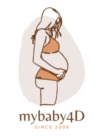There are multiple benefits to obtaining an elective entertainment-only 4D ultrasound session
4D ultrasound promotes early bonding
Anecdotal evidence — eg. every expecting mother’s smile when she sees her unborn baby — is clear, but studies also show what every 3D/4D ultrasound tech already knows, which is that 3D/4D prenatal ultrasound promotes bonding between mother and fetus/unborn baby. See a few key studies we’ve highlighted for you below.
At Prenatal Ultrasound of Glendale, we’re proud to help expecting mother’s (and expecting father’s) across Los Angeles and Southern California experience the potential emotional/bonding benefits of prenatal 3D/4D ultrasound. Call us at (818) 243-7010 for questions, or to schedule your 4D ultrasound session.

A few studies on 3D/4D ultrasound's beneficial impacts on mother-baby prenatal bonding
(1) Through a Glass Darkly: Ultrasound and Prenatal Bonding
- First published – December 1990, and presented at the Eight Birth Conference in March of 1989 in San Francisco
- Author(s) – Judith M. Lumley
- Citations – 51
- Link – https://onlinelibrary.wiley.com/doi/10.1111/j.1523-536X.1990.tb00025.x
(Abstract) Prenatal ultrasound scans are believed to enable mothers to form an early affectionate bond to their child, to provide a reassuring image of the fetus, and to promote improvements in mothers’ health behaviors on the behalf of the fetus. Observational studies suggest that scans done early may slightly improve maternal-fetal bonding but that those done after quickening are not associated with attachment. Short-term effects on maternal health behaviors, including less smoking, less drinking of alcohol, and more visits to dentists, were detected in a randomized trial when detailed information was given during the scan. This trial also suggested that women’s anxiety was actually increased during scans, and then allayed by positive feedback from the operator. Not all women considered scans reassuring in one interview study, and other authors found that mothers’ interpretations of scans depended on their personal and social circumstances. As used in everyday practice, ultrasound scans are not always accompanied by feedback, and when feedback occurs it is sometimes in the form of slips of the tongue, incorrect diagnoses, identification of structures that cannot be deciphered, and language that is unfamiliar and alarming to mothers. This “diagnostic toxicity” of ultrasound scans of the fetus has not been studied.
(2) Three-dimensional ultrasound and maternal bonding, a third trimester study and a review
- First published – January 2013
- Author(s) – Various (see link below)
- Citations – 43
- Link – https://pubmed.ncbi.nlm.nih.gov/23169046/
(Abstract) The objective was to compare the effect of third trimester three-dimensional and four-dimensional (3D/4D) versus two-dimensional (2D) ultrasound (US) of the fetal face on maternal bonding. Studies quantifying the psychological effect of 3D/4D US on mothers, pregnant of a fetus with no detectable abnormalities, were reviewed. One hundred sixty Caucasian women attended a third trimester 3D/4D or 2D US examination. Women filled out the Maternal Antenatal Attachment Scale (MAAS) 1 to 2 weeks before (MAAS1) and 1 to 2 weeks after (MAAS2) the US examination. Visibility, recognition and attractiveness were assessed. Within both US groups, the MAAS2 scores were significantly higher than the MAAS1 scores (p < 0.0001). No differences in MAAS scores between the US groups emerged. Visibility and recognition were significantly positively related with the increase in MAAS scores (p = 0.003 and p = 0.042) in the 3D/4D group. Of 13 psychological studies, eight studies evaluated bonding and found no difference between 3D/4D and 2D US. The effect of 3D/4D US on satisfaction or perception showed conflicting results, and on anxiety/stress, reduction was the same as after 2D US. Bonding increases after either a 3D/4D or 2D US. The effect of 3D/4D US on bonding is stronger at better degrees of visibility and recognition.
(3) Ultrasound and Its Role in Maternal-Fetal Bonding
- First published – Sep/Oct 1995
- Author(s) – Pam West
- Link – https://journals.sagepub.com/doi/10.1177/875647939501100508
(4) Effects of ultrasound on maternal-fetal bonding: a comparison of two- and three-dimensional imaging
- First published – May 2005
- Author(s) – Various (see link below)
- Link – https://pubmed.ncbi.nlm.nih.gov/15846757
(Abstract) The purpose of this study was to evaluate the effect of two-dimensional (2DUS) compared to three-dimensional ultrasound (3DUS) imaging on the maternal-fetal bonding process. Fifty mothers who had 2DUS and 50 who had 2DUS and 3DUS were included in the study. A postpartum survey by telephone interview was carried out to assess maternal-fetal bonding. Bonding was evaluated by analysis of extent of prenatal image sharing, maternal ability to form a mental picture of the baby and mother’s comments about their ultrasound images. Data were analyzed using the independent t-test, Chi-square and Mann-Whitney U-tests. Mothers who received 3DUS showed their ultrasound images to more people (median, 27.5; interquartile range, 14.5-40.0) than mothers receiving 2DUS alone (median, 11.0; interquartile range, 5.0-25.5) (P < 0.001, Z = -3.539). Eighty-two percent of the subjects screened with 3DUS had a greater tendency to form a mental picture of the baby postexamination compared to 39% of the 2DUS subjects (P < 0.001, Z = -3.614). Mothers receiving a 3DUS study were more likely to receive comments on the similarities/differences of the neonate compared to those having 2DUS studies. Furthermore, 70% of the mothers receiving 3DUS felt they ‘knew’ the baby immediately after birth vs. 56% of the mothers receiving 2DUS (P = 0.009, Z = -2.613). Both 2DUS and 3DUS experiences were positive, however, the comments made by the mothers undergoing 3DUS (n = 18) were more exclamatory (amazed, wonderful, fabulous) than those undergoing 2DUS (n = 4). Patients having a 3DUS examination consistently scored higher than those having a 2DUS examination alone for all categories of maternal-fetal bonding. 3DUS appears to more positively influence the perceptions of mothers to their babies postbirth compared to 2DUS. Specifically, mothers who had 3DUS showed their ultrasound images to a greater number of people compared to mothers who had 2DUS alone and this may represent mother’s social support system. 3DUS may have a greater impact on the maternal-fetal bonding process.
